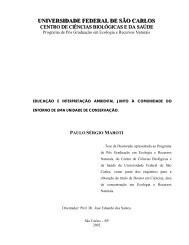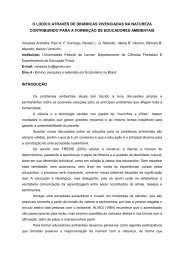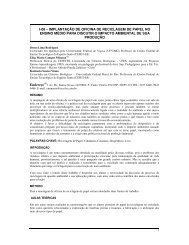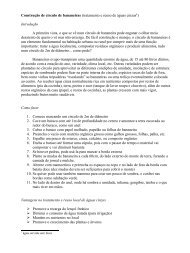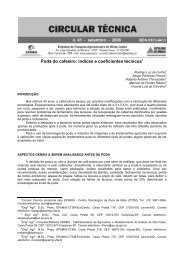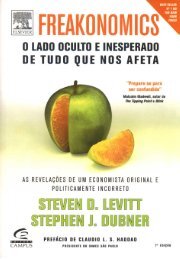Wicked Problems
Wicked Problems
Wicked Problems
Create successful ePaper yourself
Turn your PDF publications into a flip-book with our unique Google optimized e-Paper software.
<strong>Wicked</strong> <strong>Problems</strong><br />
Structuring Social Messes with Morphological Analysis<br />
© Tom Ritchey 2005-2008<br />
Swedish Morphological Society<br />
(Downloaded from: www.swemorph.com)<br />
If you work in an organisation that deals with long-term social, commercial or policy<br />
related planning, then you’ve got wicked problems. You may not call them by this name,<br />
but you know what they are. They are those complex, ever changing societal and<br />
organisational planning problems that you haven’t been able to treat with much success,<br />
because you haven’t even been able to define and structure them properly. They are messy,<br />
devious, and reactive, i.e. they fight back when you try to “resolve” them.<br />
Introduction<br />
In 1973, Horst Rittel and Melvin Webber, both urban planners at the University of Berkley in<br />
California, wrote an article for Policy Sciences with the astounding title “Dilemmas in a General<br />
Theory of Planning”. In this landmark article, the authors observed that there is a whole realm of<br />
social planning problems that cannot be successfully treated with traditional linear, analytical<br />
approaches. They called these wicked problems, in contrast to tame problems.<br />
A year later, in his book “Re-designing the Future”, Russell Ackoff (1974) essentially put<br />
forward the same concept (although in less detail), which he called a “mess”, and which later<br />
became a “social mess” (Horn, 2001).<br />
Although we are (somewhat) wiser today, and less susceptible to the belief that complex social<br />
planning problems can be “solved” by linear methods akin to engineering solutions, it is<br />
instructive to look at the original formulation of the distinction between “wicked” and “tame”<br />
problems.<br />
First, let’s look at what characterises a tame problem (Conklin, J, 2001, p.11). A tame problem<br />
has a relatively well-defined and stable problem statement.<br />
has a definite stopping point, i.e. we know when a solution is reached.<br />
has a solution which can be objectively evaluated as being right or wrong.<br />
belongs to a class of similar problems which can be solved in a similar manner.<br />
has solutions which can be tried and abandoned.<br />
<strong>Wicked</strong> problems are completely different. <strong>Wicked</strong> problems are ill-defined, ambiguous and<br />
associated with strong moral, political and professional issues. Since they are strongly<br />
stakeholder dependent, there is often little consensus about what the problem is, let alone how to<br />
resolve it.
2<br />
Furthermore, wicked problems won’t keep still: they are sets of complex, interacting issues<br />
evolving in a dynamic social context. Often, new forms of wicked problems emerge as a result<br />
of trying to understand and solve one of them.<br />
The most evident, and important, wicked problems are complex, long-term social and<br />
organisational planning problems. Examples:<br />
How should we fight the “War on Terrorism?”<br />
How do we get genuine democracies to emerge from authoritarian regimes?<br />
What is a good national immigration policy?<br />
How should scientific and technological development be governed?<br />
How should we deal with crime and violence in our schools?<br />
How should our organisation develop in the face of an increasingly uncertain future?<br />
“The classical systems approach … is based on the assumption that a planning project can be<br />
organized into distinct phases: ‘understand the problems’, ‘gather information,’ ‘synthesize<br />
information and wait for the creative leap,’ ‘work out solutions’ and the like. For wicked<br />
problems, however, this type of scheme does not work. One cannot understand the problem<br />
without knowing about its context; one cannot meaningfully search for information without the<br />
orientation of a solution concept; one cannot first understand, then solve.” (Rittel & Webber,<br />
1974, p. 161.)<br />
Ten Criteria for <strong>Wicked</strong> <strong>Problems</strong><br />
Rittel and Webber characterise wicked problems by the following 10 criteria. (It has been pointed<br />
out that some of these criteria are closely related or have a high degree overlap, and that they<br />
should therefore be condensed into four or five more general criteria. I think that this is a mistake,<br />
and that we should treat these criteria as arising from 10 more or less specifically encountered<br />
“frustrations” the authors have experienced in dealing with complex social planning issues.)<br />
1. There is no definite formulation of a wicked problem.<br />
“The information needed to understand the problem depends upon one’s idea for solving it. This<br />
is to say: in order to describe a wicked problem in sufficient detail, one has to develop an<br />
exhaustive inventory for all the conceivable solutions ahead of time.” [This seemingly incredible<br />
criterion is in fact treatable. See below.]<br />
2. <strong>Wicked</strong> problems have no stopping rules.<br />
In solving a tame problem, “… the problem-solver knows when he has done his job. There are<br />
criteria that tell when the solution, or a solution, has been found”. With wicked problems you<br />
never come to a “final”, “complete” or “fully correct” solution – since you have no objective<br />
criteria for such. The problem is continually evolving and mutating. You stop when you run out<br />
of resources, when a result is subjectively deemed “good enough” or when we feel “we’ve done<br />
what we can…”<br />
3. Solutions to wicked problems are not true-or-false, but better or worse.<br />
The criteria for judging the validity of a “solution” to a wicked problem are strongly stakeholder<br />
dependent. However, the judgments of different stakeholders …“are likely to differ widely to
3<br />
accord with their group or personal interests, their special value-sets, and their ideological<br />
predilections.” Different stakeholders see different solutions as simply better or worse.<br />
4. There is no immediate and no ultimate test of a solution to a wicked problem.<br />
“… any solution, after being implemented, will generate waves of consequences over an<br />
extended – virtually an unbounded – period of time. Moreover, the next day’s consequences of<br />
the solution may yield utterly undesirable repercussions which outweigh the intended advantages<br />
or the advantages accomplished hitherto.”<br />
5. Every solution to a wicked problem is a “one-shot operation”; because there is no<br />
opportunity to learn by trial-and-error, every attempt counts significantly.<br />
“… every implemented solution is consequential. It leaves “traces” that cannot be undone … And<br />
every attempt to reverse a decision or correct for the undesired consequences poses yet another<br />
set of wicked problems … .”<br />
6. <strong>Wicked</strong> problems do not have an enumerable (or an exhaustively describable) set of<br />
potential solutions, nor is there a well-described set of permissible operations that may be<br />
incorporated into the plan.<br />
“There are no criteria which enable one to prove that all the solutions to a wicked problem have<br />
been identified and considered. It may happen that no solution is found, owing to logical<br />
inconsistencies in the ‘picture’ of the problem.”<br />
7. Every wicked problem is essentially unique.<br />
“There are no classes of wicked problems in the sense that the principles of solution can be<br />
developed to fit all members of that class.” …Also, …”Part of the art of dealing with wicked<br />
problems is the art of not knowing too early which type of solution to apply.” [Note: this is very<br />
important point. See below.]<br />
8. Every wicked problem can be considered to be a symptom of another [wicked] problem.<br />
Also, many internal aspects of a wicked problem can be considered to be symptoms of other<br />
internal aspects of the same problem. A good deal of mutual and circular causality is involved,<br />
and the problem has many causal levels to consider. Complex judgements are required in order to<br />
determine an appropriate level of abstraction needed to define the problem<br />
9. The causes of a wicked problem can be explained in numerous ways. The choice of<br />
explanation determines the nature of the problem’s resolution.<br />
“There is no rule or procedure to determine the ‘correct’ explanation or combination of<br />
[explanations for a wicked problem]. The reason is that in dealing with wicked problems there<br />
are several more ways of refuting a hypothesis than there are permissible in the [e.g. physical]<br />
sciences.”<br />
10. [With wicked problems,] the planner has no right to be wrong.<br />
In “hard” science, the researcher is allowed to make hypotheses that are later refuted. Indeed, it is<br />
just such hypothesis generation and refutation that is a primary motive force behind scientific
4<br />
development (Ritchey, 1991). One is not penalised for making hypotheses that turn out to be<br />
wrong. “In the world of … wicked problems no such immunity is tolerated. Here the aim is not<br />
to find the truth, but to improve some characteristic of the world where people live. Planners are<br />
liable for the consequences of the actions they generate …”<br />
Tackling <strong>Wicked</strong> <strong>Problems</strong> with General Morphological Analysis<br />
How, then, does one tackle wicked problems? Some 20 years after Rittel & Webber wrote their<br />
article, Jonathan Rosenhead (1996), of the London School of Economics, presented the following<br />
criteria for dealing with complex social planning problems – criteria that were clearly influenced<br />
by the ideas presented by Rittel, Webber and Ackoff.<br />
• accommodate multiple alternative perspectives rather than prescribe single solutions<br />
• function through group interaction and iteration rather than back office calculations<br />
• generate ownership of the problem formulation through transparency<br />
• facilitate a graphical (visual) representation for the systematic, group exploration of a<br />
solution space<br />
• focus on relationships between discrete alternatives rather than continuous variables<br />
• concentrate on possibility rather than probability<br />
Group facilitated, computer-aided General Morphological Analysis (GMA) is fully attuned to<br />
these criteria. Developed in the middle of the 1990s, GMA was designed as a non-quantified<br />
problem structuring method (PSM), which results in an inference model which strives to<br />
represent the total problem space, and as many of the potential solutions to the given problem<br />
complex as possible (Ritchey, 2002). This, in itself, goes a long way in satisfying Rittel and<br />
Webber’s first – seemingly incredible – criterion concerning wicked problems: “… in order to<br />
describe a wicked problem in sufficient detail, one has to develop an exhaustive inventory for all<br />
the conceivable solutions ahead of time.” (My emphasis)<br />
As a process, GMA goes through a number of iterative steps or phases which represent cycles of<br />
analysis and synthesis – the basic method for developing (scientific) models (Ritchey, 1991). The<br />
analysis phase begins by identifying and defining the most important dimensions of the problem<br />
complex to be investigated. Each of these dimensions is then given a range of relevant (discrete)<br />
values or conditions. Together, these make up the variables or parameters of the problem<br />
complex. A morphological field is constructed by setting the parameters against each other, in<br />
parallel columns, representing an n-dimensional configuration space. A particular constructed<br />
“field configuration” is designated by selecting a single value from each of the variables. This<br />
marks out a particular state or (formal) solution within the problem complex.<br />
The morphological field represents the total “problem space”, and can contain many thousands –<br />
or even hundreds of thousands – of possible (formal) solutions. A proper “solution space” is<br />
synthesized by a process of internal cross-consistency assessment (CCA). All of the parameter<br />
values in the morphological field are compared with one another, pair-wise, in the manner of a<br />
cross-impact matrix. As each pair of conditions is examined, a judgment is made as to whether –<br />
or to what extent – the pair can coexist, i.e. represent a consistent relationship. Note that there is<br />
no reference here to causality or probability, but only to possibility through mutual consistency.
5<br />
Using this technique, a typical morphological field can be reduced by up to 90% or even 99%,<br />
depending on the nature of the problem.<br />
When this solution (or outcome) space is synthesized, the resultant morphological field becomes<br />
an inference model, in which any parameter (or multiple parameters) can be selected as "input",<br />
and any others as "output". Thus, with computer support, the field can be turned into a laboratory<br />
with which one can designate initial conditions and examine alternative solutions (Figure 1).<br />
Figure 1. Scenario-strategy model for a Swedish Extended Producer Responsibility system. The selected<br />
scenario (red) is defined by the following 8 scenario parameters (dark blue). Compatible EPR strategies<br />
are shown in light blue.<br />
It is also important to heed Rittel and Webber’s seventh criterion: “Part of the art of dealing with<br />
wicked problems is the art of not knowing too early which type of solution to apply.” In<br />
morphological analysis, we call this “remaining in the mess”, i.e. keeping one’s options open<br />
long enough to explore as many relationships in the problem topology as possible, before starting<br />
to formulate solutions. This can be a frustrating process for inveterate “problem solvers”, but is<br />
an absolutely necessary procedure when working with wicked problems and social messes.<br />
Finally, the process of creating morphological inference models through facilitated group<br />
workshops is as important at the end-product – i.e. the model itself. As many stakeholders as<br />
possible should be engaged in the work, in order to create a common terminology, common<br />
problem concept and common modelling framework. Principal stakeholders and subject<br />
specialists should be brought together in a series of workshops to collectively 1) structure as<br />
much of the problem space as possible, 2) synthesize solution spaces, 3) explore multiple<br />
solutions on the basis of different drivers and interests and 4) analyse stakeholder structures. The
6<br />
different stakeholders do not have to agree on a single, common solution, but must be<br />
encouraged to understand each other's positions and contexts.<br />
As is the case with all methods dealing with complex social planning problems, the results of a<br />
morphological analysis are no better than the quality of the inputs provided. However, even here<br />
the morphological approach has some clear advantages. It expressly provides for a good deal of<br />
in-built “garbage detection”, since poorly defined parameters and incomplete ranges of<br />
conditions are immediately revealed when one begins the task of cross-consistency assessment.<br />
These assessments simply cannot be made until the morphological field is well defined and the<br />
working group is in agreement about what these definitions mean. This type of garbage detection<br />
is extremely important when working with wicked problems and social messes.<br />
References<br />
Ackoff, R (1974). Re-defining the Future. Wiley: London.<br />
Conklin, J. (2001). “<strong>Wicked</strong> <strong>Problems</strong> and Social Complexity.” CogNexus Institute. [Online]. Available<br />
from the World Wide Web: http://cognexus.org/wpf/wickedproblems.pdf.<br />
Horn, R (2001). Knowledge Mapping for Complex Social Messes. A presentation to the “Foundations in<br />
the Knowledge Economy” at the David and Lucile Packard Foundation. [Online] Available on the World<br />
Wide Web: http://www.stanford.edu/~rhorn/a/recent/spchKnwldgPACKARD.pdf.<br />
Poppendieck, M (2002). “<strong>Wicked</strong> <strong>Problems</strong>”. Poppendieck.LLC. [Online]. Available from the World<br />
Wide Web: http://www.poppendieck.com/wicked.htm.<br />
Ritchey, T. (1991). “Analysis and Synthesis - On Scientific Method based on a Study by Bernhard<br />
Riemann”. Syst Res 8(4):21-41. (Revised 1996) [Online]. Available from the World Wide Web:<br />
www.swemorph.com/pdf/anaeng-r.pdf.<br />
Ritchey, T. (1998). "Morphological Analysis - A general method for non-quantified modelling". Adapted<br />
from a paper presented at the 16th Euro Conference on Operational Analysis. [Online]. Available from the<br />
World Wide Web: www.swemorph.com/pdf/gma.pdf.<br />
Ritchey, T. (2002). “Modelling Complex Socio-Technical Systems using Morphological Analysis.”<br />
Adapted from an address to the Swedish Parliamentary IT Commission, Stockholm, December 2002.<br />
[Online]. Available from the World Wide Web: www.swemorph.com/pdf/it-webart.pdf.<br />
Ritchey, T.: "Problem Structuring using Computer-Aided Morphological Analysis". Journal of the<br />
Operational Research Society (2006) 57, 792-801. Available as a post-peer-review, pre-copyedit version<br />
at www.swemorph.com/pdf/psm-gma.pdf. The definitive publisher-authenticated version is available<br />
online ( free for JORS subscribers) at:<br />
http://www.palgrave-journals.com/jors/journal/v57/n7/abs/2602177a.html<br />
Rittel, H., and Webber, M. (1973). “Dilemmas in a General Theory of Planning”. Policy Sciences, Vol. 4,<br />
pp 155-169. Elsevier Scientific Publishing Company, Inc: Amsterdam.<br />
Rosenhead,. J. (1996). What's the problem? An introduction to problem structuring methods. Interfaces<br />
26(6):117-131.





